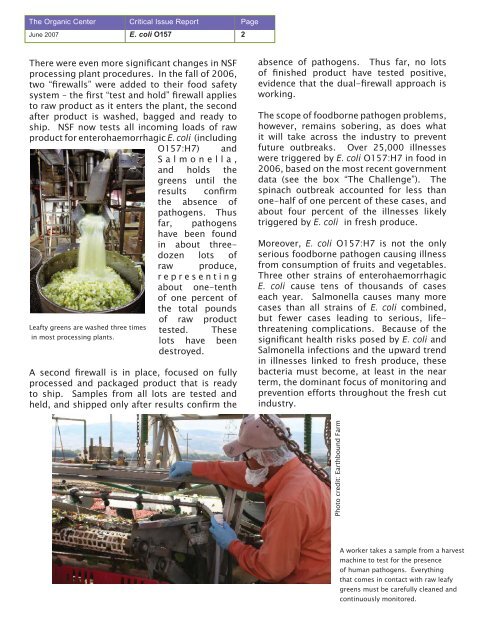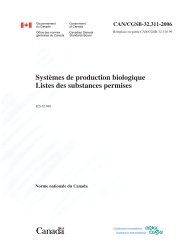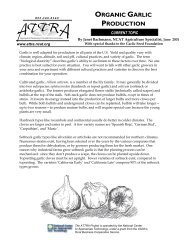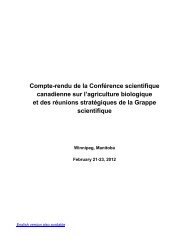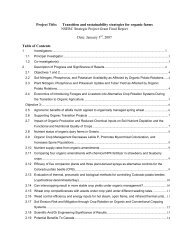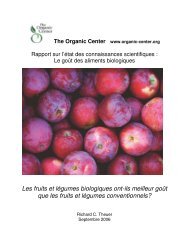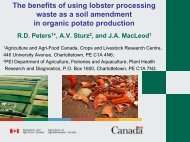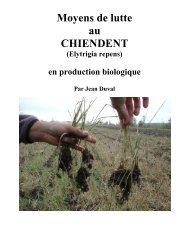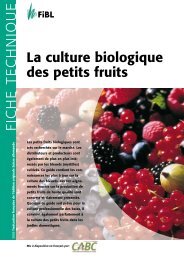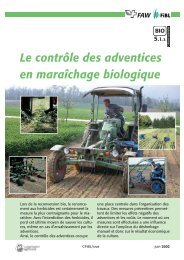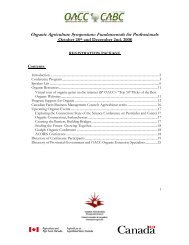Preventing E. Coli 0157 Outbreaks in Leafy Greens
Preventing E. Coli 0157 Outbreaks in Leafy Greens
Preventing E. Coli 0157 Outbreaks in Leafy Greens
You also want an ePaper? Increase the reach of your titles
YUMPU automatically turns print PDFs into web optimized ePapers that Google loves.
The Organic Center Critical Issue Report Page<br />
June 200707 E. coli O157 2<br />
There were even more significant changes <strong>in</strong> NSF<br />
process<strong>in</strong>g plant procedures. In the fall of 2006,<br />
two “firewalls” were added to their food safety<br />
system – the first “test and hold” firewall applies<br />
to raw product as it enters the plant, the second<br />
after product is washed, bagged and ready to<br />
ship. NSF now tests all <strong>in</strong>com<strong>in</strong>g loads of raw<br />
product for enterohaemorrhagic E. coli (<strong>in</strong>clud<strong>in</strong>g<br />
O157:H7) and<br />
Salmonella,<br />
and holds the<br />
greens until the<br />
results confirm<br />
the absence of<br />
pathogens. Thus<br />
far, pathogens<br />
have been found<br />
<strong>in</strong> about threedozen<br />
lots of<br />
raw produce,<br />
represent<strong>in</strong>g<br />
about one-tenth<br />
of one percent of<br />
the total pounds<br />
of raw product<br />
Leafty greens are washed three times<br />
tested. These<br />
<strong>in</strong> most process<strong>in</strong>g plants.<br />
lots have been<br />
destroyed.<br />
A second firewall is <strong>in</strong> place, focused on fully<br />
processed and packaged product that is ready<br />
to ship. Samples from all lots are tested and<br />
held, and shipped only after results confirm the<br />
absence of pathogens. Thus far, no lots<br />
of f<strong>in</strong>ished product have tested positive,<br />
evidence that the dual-firewall approach is<br />
work<strong>in</strong>g.<br />
The scope of foodborne pathogen problems,<br />
however, rema<strong>in</strong>s sober<strong>in</strong>g, as does what<br />
it will take across the <strong>in</strong>dustry to prevent<br />
future outbreaks. Over 25,000 illnesses<br />
were triggered by E. coli O157:H7 <strong>in</strong> food <strong>in</strong><br />
2006, based on the most recent government<br />
data (see the box “The Challenge”). The<br />
sp<strong>in</strong>ach outbreak accounted for less than<br />
one-half of one percent of these cases, and<br />
about four percent of the illnesses likely<br />
triggered by E. coli <strong>in</strong> fresh produce.<br />
Moreover, E. coli O157:H7 is not the only<br />
serious foodborne pathogen caus<strong>in</strong>g illness<br />
from consumption of fruits and vegetables.<br />
Three other stra<strong>in</strong>s of enterohaemorrhagic<br />
E. coli cause tens of thousands of cases<br />
each year. Salmonella causes many more<br />
cases than all stra<strong>in</strong>s of E. coli comb<strong>in</strong>ed,<br />
but fewer cases lead<strong>in</strong>g to serious, lifethreaten<strong>in</strong>g<br />
complications. Because of the<br />
significant health risks posed by E. coli and<br />
Salmonella <strong>in</strong>fections and the upward trend<br />
<strong>in</strong> illnesses l<strong>in</strong>ked to fresh produce, these<br />
bacteria must become, at least <strong>in</strong> the near<br />
term, the dom<strong>in</strong>ant focus of monitor<strong>in</strong>g and<br />
prevention efforts throughout the fresh cut<br />
<strong>in</strong>dustry.<br />
Photo credit: Earthbound Farm<br />
A worker takes a sample from a harvest<br />
mach<strong>in</strong>e to test for the presence<br />
of human pathogens. Everyth<strong>in</strong>g<br />
that comes <strong>in</strong> contact with raw leafy<br />
greens must be carefully cleaned and<br />
cont<strong>in</strong>uously monitored.


